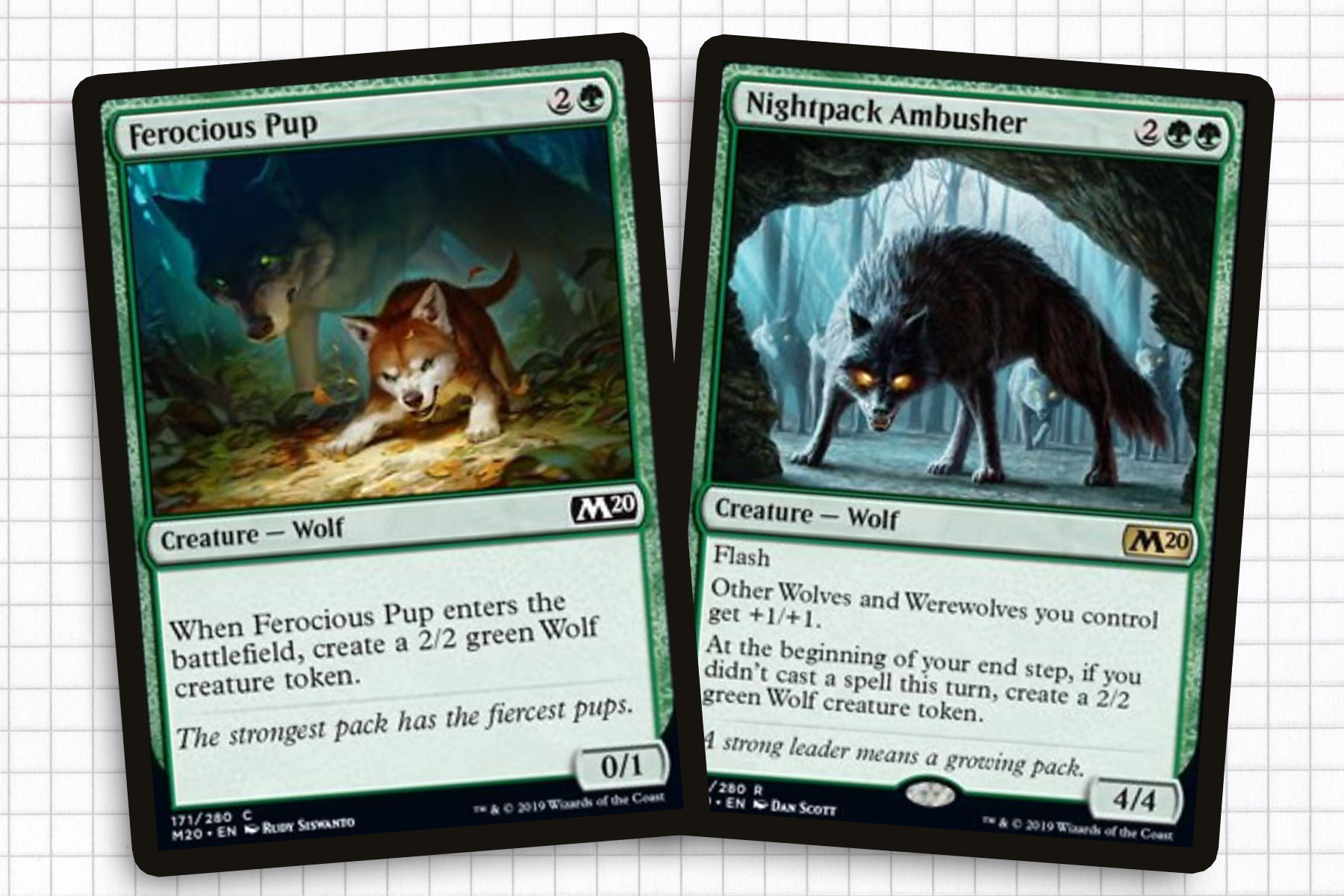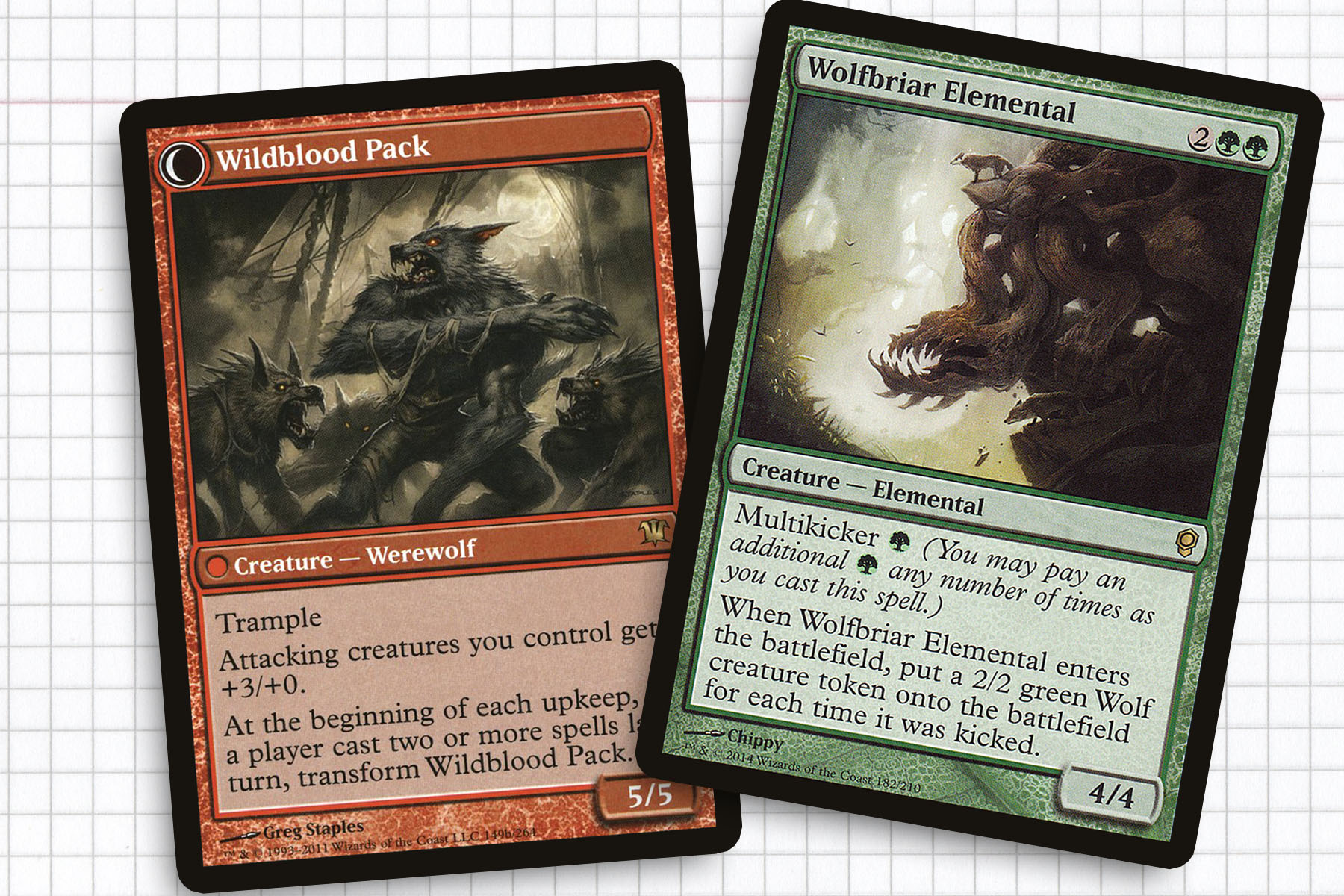Like many, I really love dogs. But from an early age, something about the Egyptian god Anubis and Digimon’s Garurumon drew me to wolves and made them are one of my favorite real-world animals. Upon discovering Magic, the allure of the wolf tribe had a very strong pull on me as well, even when they tribe had no solid support. All the way back to 7th Edition, when I first saw Lone Wolf, I was immediately intrigued. This not only came from the strange combat mechanic that I would later discover on the nigh-unstoppable Thorn Elemental, but it’s place in green, the new player’s best friend.
Since that time, I have taken my small victories with wolf support in the form of Immerwolf, Wolfbriar Elemental, and Raised by Wolves. But as War of the Spark brought about a small wolves-matter theme with Arlinn, Voice of the Pack and Tolsimir, Friend to Wolves, I felt we were poised for a second coming of wolves’ place in the Standard format, possibly coming in the Fall. Imagine my surprise when the Magic Core 2020 started delivering little nuggets for the tribe, peaking for me with Ferocious Pup.
This surge in the creature type prompted me to look to Oathbreaker and finally give Arlinn Kord a spin; both for her expansion of color identity over Arlinn, Voice of the Pack, but also to put forward a deck that doesn’t intend to focus at all on the werewolf tribe typically highlighted with either Arlinn. Aside from two werewolves, I wanted this deck to highlight the majestic wolf and build something that can be aggressive in a format that rewards speed.
For those who are new to the Oathbreaker format: Oathbreaker is a fun, fast, and casual singleton multiplayer format meant to highlight Planeswalkers by making them your stand in for a Commander. From there, you select an instant or sorcery card in your color identity as your signature spell. Armed with the rest of your 60-card singleton deck, you battle it out with friends in 30-60 minute games.
Oathbreaker: Arlinn Kord and Predator’s Howl
Creature: Adaptive Automaton, Arlinn’s Wolf, Chameleon Colossus, Deranged Whelp, Ferocious Pup, Huntmaster of the Fells, Immerwolf, Instigator Gang, Master of the Wild Hunt, Mayor of Avabruck, Metallic Mimic, Nightpack Ambusher, Pyreheart Wolf, Silverfur Partisan, Somberwald Alpha, Spirit of the Hunt, Taurean Mauler, Ulrich’s Kindred, Universal Automaton, Wolfbriar Elemental, Young Wolf
Artifact: Gruul Locket, Gruul Signet, Obelisk of Urd, Vanquisher’s Banner
Enchantment: Feed the Pack, Raised by Wolves, Zendikar Resurgent
Instant: Harrow
Sorcery: Howl of the Night Pack, Kindred Charge, Rampant Growth, Skyshroud Claim
Planeswalker: Arlinn, Voice of the Pack
Land: 6 Forest, 3 Mountain, Copperline Gorge, Fire-Lit Thicket, Game Trail, Gruul Guildgate, Gruul Turf, Kessig Wolf Run, Mikokoro, Center of the Sea, Mutavault, Raging Ravine, Rootbound Crag, Rugged Highlands, Stomping Ground, Temple of Abandon, Timber Gorge
Arlinn Kord
As the chief wolf planeswalker, Arlinn was an easy pick to helm this deck. I really enjoy her from a lore perspective as well. Not only has she lived past the average life expectancy for a typical planeswalker; but her status as werewolf that can only change form on Innistradtraps her in whatever form she holds when she is off-plane. That is a power set asking to be used well by a skilled writer.
One of the big draws to this deck—besides the tribe—is the nature of being a creature-based deck. In my experience, Oathbreaker games often get sidetracked by spell-based decks in the opening turns of the game, with the most threatening spellcaster being the first target of people’s ire. My hope in most of those games is that by building up a reasonable board, I can translate my lack of being threatening into a win.
Examining wolves, one of their downfalls is that they are often not very big and lack evasion. As a card, Arlinn does a lot of leg work to help keep my board stocked with creatures, buffing at least one as protection and then transforming to allow my whole team to be menacing. This should in theory help to compensate for some of the admitted weaknesses. Unlike past Oathbreaker decks where I built towards the planeswalker ultimate, I don’t think we’ll need to be so focused on that, using her other abilities instead.
The other side of the equation with any Oathbreaker deck is the signature spell. My choice to use Predator’s Howl as Arlinn’s signature spell came from the want for something that would be more practical than the typical go-to spell, Moonmist. As I asked myself where the weaknesses in the deck might lie, an instant-speed creature at a moment’s notice or an entire pack of wolves to rebuild after a board wipe felt really important.

Wolf Tribal
For any tribe, you know you’ve made it when Wizards gives you a lord to help enhance your creatures. For wolves, that has come in the form of Immerwolf and the freshly previewed Nightpack Ambusher. As a lord with flash, Nightpack Ambusher not only enhances our wolves as a combat trick, but can grow our ranks every turn.
It’s also wise to remember that Wizards has been very kind to players who love unconventional tribes. Over the years we’ve been given Adaptive Automaton, Obelisk of Urd, and Vanquisher’s Banner as colorless anthem effects for whichever tribe we happen to love the most. This should prove to be invaluable since, as we’ve discussed, wolves have a disadvantage in size compared to other tribes.
Wolves excel as creature tokens. The ability to recur tokens in the form of Feed the Pack, Raised by Wolves, and Huntmaster of the Fells means that the tribe often has the ability to easily go wide, which keeps it relevant throughout the game. This is one aspect of the deck that is hurt by the smaller deck size in comparison to Commander, as I wish I could include more of the token creators I often take for granted.

Hidden Gems
Sprinkled throughout this deck is a handful of cards that are not only good for this deck, but could really be valuable in any deck in the Gruul color identity. For tribal decks, I am surprised I don’t see Kindred Charge often. I can understand that for many tribes, going wide isn’t always the modus operandi. But with so many creatures having powerful enter-the-battlefield triggers, I’m surprised players aren’t looking for more chances to double them up.
I wish I remembered to put Instigator Gang into decks more often. The werewolf may fit the flavor of my deck, but both faces of the card can swing games in exciting ways. This card has turned the tide of combat as an on-board trick more times than I can count. Someone is bound to let them transform before I untap, meaning my whole team can often attack for huge swaths of damage. I’m excited to see how this card performs in a format where we all start at twenty life.
Having Arlinn around to grant my team trample is nice, but often I find myself happy to have Somberwald Alpha around as redundancy. Not only does this wolf make blocking a little harder while making our creatures more hardy, but often it can invalidate chump blocking by granting creatures trample at a moment’s notice. While both are representative of wolves, Wolfbriar Elemental and Chameleon Colossus would be at home in any deck running green. I doubt that I need to sell any players with years of experience with the Colossus, but the Elemental may hide under a lot of people’s radar. Since 2/2 bodies can be useful regardless of creature type, making bodies via multikicker can be tremendously valuable anywhere on your curve.
Even though the tribe is currently seeing a good wave of support, I will always be an advocate for more cards that help support the wolf tribe. I think the biggest ask is still some kind of Naya-aligned legendary creature to allow the biggest swath of the tribe to be used. Preferably in the form of an elf that cares about the tribe, to allow this aspirational deck to have a general that could be championed by Wren’s Run Packmaster. No doubt that Tolsimir, Friend to Wolves is a good first step and a sign that Wizards has listened.
As I’ve said during my past musings on Oathbreaker, I find the format to be tremendous fun and a good alternative to Commander when time won’t allow for a 90-minute or longer game. For me, I envision that the format could easily stay popular and be the perfect marriage between Commander and the nostalgic days of sixty-card Magic that many had at lunch tables in college or high school. Regardless, I am bound to build around wolves in whichever format I play in, so you know they will be making more appearances in the future.
Ryan Sainio is a Graphic Designer who writes about EDH and the EDH community. He has been playing Magic: The Gathering since 7th Edition in 2002 and values flavorful and fun gameplay over competitively optimized decks.

